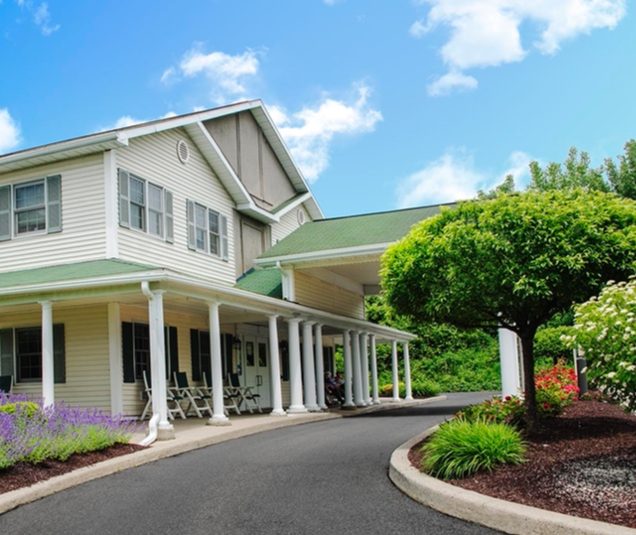Choosing the right fit for senior living can feel overwhelming. There are many options for care, each offering a distinct approach towards your loved one’s needs. Two of the most common types of senior living are assisted living and memory care, but how are these different?
The key differences between assisted living and memory care are:
- The level of care
- The staff training
- Environment and design
- Daily activities and support
What Is Assisted Living?
Assisted living bridges the gap between independence and ongoing support. It’s designed to help older adults to maintain an active, engaging lifestyle. With assisted living, if a daily task becomes challenging, a team of caregivers is there to step in and help.
Assisted living is an option that balances freedom with accessible assistance as needed. When your loved one moves to assisted living, they can get help with things like:
- Daily tasks such as dressing, bathing, or grooming
- Medication management & reminders
- Meal preparation tailored to health needs
- Laundry & housekeeping services
- Scheduled social & recreational activities
This type of support empowers residents every day. It’s an amazing way for seniors to enjoy their day-to-day life with comfort and dignity. Assisted living is a great fit for older adults who value their independence but welcome a little help when needed.
What Is Memory Care?
On the other hand, memory care is a little more specialized. It’s about providing a safe, structured environment for seniors living with dementia or Alzheimer’s. These communities focus on creating a routine while meeting your loved one’s unique needs.
Memory care gives your loved one a place to maintain their dignity and quality of life. The teams working in memory care are trained to handle the unique challenges of memory loss and cognitive decline. This lifestyle takes a compassionate approach to helping your loved one every day.
Memory care offers:
- Personalized care plans tailored to cognitive needs
- Secure environments to reduce wandering risks
- Activities designed to support memory and cognitive function
- Specially trained staff to manage dementia-related behaviors
- Nutritious meals to support overall health and wellness
Memory care combines professional care with compassion. It offers a dignified lifestyle in a structured setting that helps your loved one every day.
The Difference Between Assisted Living & Memory Care
Both assisted living and memory care provide valuable solutions. However, it’s important to note that their focus and approach differ. One option is often more ideal than the other—depending on your loved one’s specific needs.
There are Four key differences between assisted living and memory care.
- The level of care
- The staff training
- Environment & design
- Daily activities & support
So how are these different?
Level Of Care
First, the most significant difference is the type of care provided. While both services provide professional support, the specific care provided depends on the lifestyle.
Assisted living is about providing everyday support to help your loved one stay independent where they can. Usually, those living in assisted living need assistance with tasks like personal care or managing medication.
Meanwhile, memory care caters to those who need more advanced support for cognitive conditions. Rather than focusing on independence, memory care provides tailored care and a structured lifestyle. This is about maintaining dignity and quality of life for those living with dementia and memory-related conditions.
Staff Training
Another key difference is the level of training that staff undergo.
In assisted living, caregivers are trained to provide everyday support. They provide care for daily tasks to help your loved one stay independent. Some of these tasks, like managing medication or assisting with personal grooming, require specific training.
However, staff in memory care receive specialized training. Dementia is extremely complex, and it takes an individualized approach to properly care for those living with this condition. This additional training helps caregivers effectively manage dementia-related behaviors like wandering, confusion, or agitation.

Environment & Design
Each type of senior living community is designed to cater to different needs. Because of this, the physical environment is often different.
Homes in assisted living apartments often resemble condos, apartments, or even townhouses. There’s a strong focus on comfort and community. There are even shared spaces, activity rooms, and plenty of on-site amenities to encourage everyday activities.
Memory care environments are different. They’re designed to emphasize safety, like secure entryways and clear layouts, to reduce confusion and wandering. There are special features like maps, clearly labeled areas, and more to help residents safely navigate their homes.
Daily Activities & Support
Whether it’s assisted living or memory care, senior living communities provide all kinds of interesting events and activities. However, the purpose of these activities differs slightly with each kind of care..
Daily activities in assisted living are designed to promote socialization, independence, and engagement. Residents can join different groups, clubs, classes, and events. These are all tailored to keeping the mind and body active while encouraging a strong sense of community.
On the other hand, memory care activities focus on supporting cognitive abilities. There are still group activities and programs, but they’re often along the lines of music therapy, arts and crafts, and sensory stimulation. These activities are about creating a calming environment where residents stay engaged and connected.
Choosing The Right Senior Living Community
Choosing the right senior living community is essential. Your loved one deserves a place they can call home—a place like ours at Peregrine Senior Living at Shaker. We’ll work with you to find a lifestyle that meets your loved one’s needs. Schedule a visit with us today—we’re looking forward to meeting you!












Honoring and expressing gratitude to our Veterans for their services and sacrifices. To all the men and women of our Armed Services, we offer our heartfelt thanks. ... See MoreSee Less
We love our sweet treats! We made pumpkin pie cheesecake dip at our cooking class. Delish! ... See MoreSee Less
Caregiving is an act of love that requires time, energy, passion, and strength. Today, show a caregiver how much you appreciate them and thank them for all they do.
Together, we can create a circle of compassion and care—for caregivers and those they care for.
peregrineshaker.com/ ... See MoreSee Less
You can now find our November activities calendar online.
These calendars are still printed and available throughout the community and are posted.
Click on the link below to view this month’s calendar!
Assisted Living: illst.us/7DY159
Memory Care: illst.us/538D0F ... See MoreSee Less
Live music with Bill & Wayne, apple cider donuts,and a staff costume parade with the Peregrine pups and the cutest kids we know! Happy Halloween!!!! ... See MoreSee Less
Our care staff demonstrate exceptional skill as party planners. They did a fantastic job decorating our Halloween party and ensuring our residents enjoyed themselves. Thank you for your dedication. ... See MoreSee Less
Happy Halloween to you and your family!
Today is about the simple joys of the season. May your day be filled with festive treats and warm memories!
peregrineshaker.com/ ... See MoreSee Less